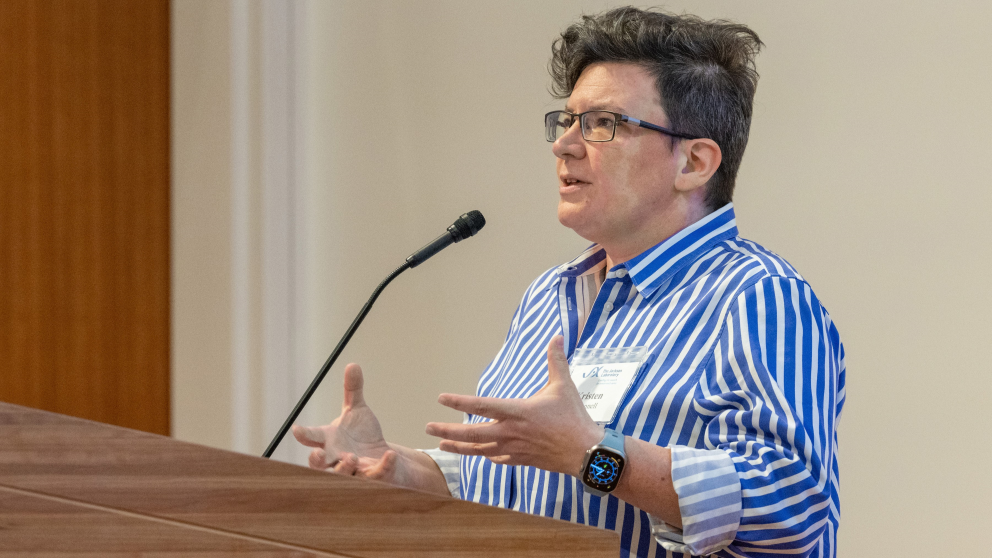 JAX Associate Professor and Alzheimer's researcher Kristen O'Connell, Ph.D., speaks to an audience in Farmington, Conn.
JAX Associate Professor and Alzheimer's researcher Kristen O'Connell, Ph.D., speaks to an audience in Farmington, Conn.
To solve Alzheimer’s disease, JAX works to understand biological factors that cause it.
When people find out that JAX Associate Professor Kristen O’Connell, Ph.D., studies Alzheimer’s disease (AD) and dementia, they start asking questions.
What is JAX is doing to address this leading cause of death in adults ages 65 and older, projected to impact more than 13 million Americans by 2050?
How close are JAX scientists to finding a treatment that does more than just slow disease progression or mitigate its symptoms?
With over $3 billion in federal funding spent annually on Alzheimer’s research, why don’t we have a solution yet?
O’Connell’s response speaks to a fundamental question that researchers have to answer before any of these can be addressed.
“We still don’t understand the basic biology of Alzheimer’s,” O’Connell said. “We still don’t know what causes it, which makes it challenging to develop a treatment that is safe and effective.”
For those desperate to help loved ones suffering from the disease, that’s hard to hear.
“It’s difficult to tell people that, after all this time, we still don’t have a drug or a treatment for their mother, their aunt or their grandparents,” she said. “And one of the biggest challenges is that by the time a person presents with symptoms, the disease has probably been going on for decades. So, it’s very hard to screen people and identify who is at risk.”
Advances through cutting-edge research and private philanthropy
Despite challenges, signs of hope exist in the field of Alzheimer’s research. One of them is in development at JAX.
In 2021, philanthropic gifts and leadership from JAX-affiliated scientist Catherine Kaczorowski, Ph.D., enabled O’Connell and her collaborators to accelerate research into a unique biological target for Alzheimer’s – a gene called TrpC3 that had not previously been associated with memory function. When they decreased the function of TrpC3 in young mice, memory improved on a long-term memory test. In aging mice, decreased function of TrpC3 prevented cognitive decline so much that the mice performed memory tasks nearly as well as their young counterparts. And in AD-susceptible mice exhibiting cognitive impairment, reduction of TrpC3 reversed their impairment, allowing them to perform as well as their wild-type counterparts that did not have the same susceptibility to the disease.
Armed with compelling data, O’Connell’s team synthesized hundreds of compounds that antagonize or bind to TrpC3. They identified a handful of promising candidates that now will undergo several months of additional cognitive memory testing.
The gift allowed O’Connell and her team to move quickly.
“We knew that if we could find a way to design an intervention for TrpC3, we could make a difference really fast,” she said. “Philanthropy was 100 percent responsible for our progress. It funded the whole project, start-to-finish, and it inspired other gifts that have kept the research going.”
An urgent need for more models
O’Connell hopes to build on her team’s TrpC3 success by conducting a more detailed study of the models she has developed to date. She noted that Alzheimer’s models are far better than a decade ago. What makes a better model? Genetic diversity.
“We need diversity in our models because not everyone experiences life the same way,” she said. “Think of aging as an example. Aging is the greatest risk factor for developing Alzheimer’s, but not everyone ages the same way.”
One of JAX’s best-known models is the “Black 6,” which is genetically resilient to Alzheimer’s. When genetic mutations for Alzheimer’s are introduced, Black 6 mice develop the hallmark amyloid plaques of the disease but not severe memory impairment or other behavioral elements of Alzheimer’s.
Kaczorowski designed a panel of mouse strains that carry familial AD mutations on a broader range of genetic backgrounds. The resulting population captured the diversity present in a human population. These results indicate that differences in our genomic makeup drive the diverse ways in which Alzheimer’s manifests itself.
Philanthropy plays a key role in advancing Alzheimer’s research at JAX by enabling researchers to develop mouse models at a scale that makes scientific breakthroughs possible.
“It takes a lot of models to make a discovery,” O’Connell said. “At JAX, we have the resources to facilitate the scope of research required, which uses thousands of mice instead of tens or hundreds. Somewhere in that mix are the pathways that represent the underlying pathophysiology of Alzheimer’s.”
As her next step, O’Connell will study models that range from Alzheimer’s-susceptible to Alzheimer’s-resilient and everything in between to see where neurological pathways differ. From there, she can nominate potential therapeutic targets as she did with TrpC3. She’s hopeful that the treatment people are seeking is well within reach.
“When something works and there is need,” she said, “it can move quickly.”